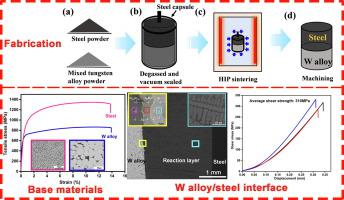Materials & Design ( IF 7.6 ) Pub Date : 2021-09-25 , DOI: 10.1016/j.matdes.2021.110127 Wentan Zhu 1 , Wensheng Liu 1 , Yunzhu Ma 1 , Qingshan Cai 1 , Jianning Wang 1 , Youteng Duan 1

|
In this study, tungsten alloy/steel composite structure has been successfully fabricated by co-sintering method using hot isotactic pressing (HIP). The microstructure and mechanical properties of co-sintered samples were investigated systematically. Experimental results show that dense co-sintered base materials were obtained with good tensile properties (870 MPa for 90 W-4.2Ni-1.8Fe-4Cu alloy and 1350 MPa for 30CrMnSiNi2A steel). The co-sintered joint contains five regions: the W alloy matrix, the diffusion-affected zone of the W alloy (η-carbides contain Fe3W3C and Fe6W6C), the reaction interlayer, the diffusion-affected zone of the steel ((Ni, Fe, Cu) solid solution), and the steel matrix. The interlayer shows solidification structure, which is composed of Fe0.64Ni0.36, Cu0.81Ni0.19, Fe3W3C and Fe2W Laves phases. The η-carbides transitional belt with thickness of 4–6 μm formed along the W grain boundaries at the interfacial region between W alloy and interlayer, which is the weakest area of the interface according to the TEM and nanoindentation test results. Furthermore, the formation mechanism of the interfacial structure is deeply discussed. The interfacial shear and tensile strengths of the co-sintered specimen is 310 MPa and 148 MPa, respectively. This technique provides a reliable method of efficient preparation of tungsten alloy/steel composite structure.
中文翻译:

HIP共烧结钨合金/钢复合结构的显微结构特征、力学性能及界面形成机制
在这项研究中,钨合金/钢复合结构已通过共烧结方法使用热等规压制(HIP)成功制造。系统地研究了共烧结样品的显微组织和力学性能。实验结果表明,获得了致密的共烧结基材,具有良好的拉伸性能(90 W-4.2Ni-1.8Fe-4Cu合金为870 MPa,30CrMnSiNi2A钢为1350 MPa)。共烧结接头包含五个区域:W 合金基体、W 合金的扩散影响区(η-碳化物包含 Fe 3 W 3 C 和 Fe 6 W 6C)、反应夹层、钢的扩散影响区((Ni、Fe、Cu)固溶体)、钢基体。夹层呈凝固组织,由 Fe 0.64 Ni 0.36、Cu 0.81 Ni 0.19、Fe 3 W 3 C 和 Fe 2 组成W Laves 阶段。根据透射电镜和纳米压痕测试结果,在钨合金和夹层之间的界面区域沿钨晶界形成了厚度为 4-6 μm 的 η-碳化物过渡带,这是界面的最薄弱区域。此外,深入讨论了界面结构的形成机制。共烧结试样的界面剪切强度和拉伸强度分别为 310 MPa 和 148 MPa。该技术为有效制备钨合金/钢复合结构提供了一种可靠的方法。











































 京公网安备 11010802027423号
京公网安备 11010802027423号